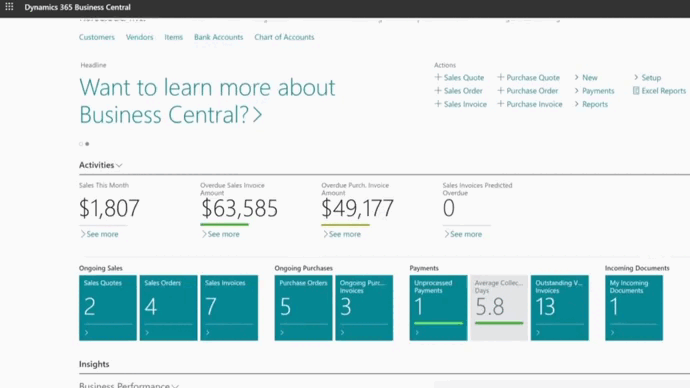Choosing an ERP system is one of the most strategic decisions your company will ever make. It impacts finance, operations, supply chain, customer service, and long-term scalability.
- According to Gartner, more than 70 % of recently implemented ERP initiatives will fail to fully meet their original business goals, and as many as 25 % may fail catastrophically.
- In real-world case studies, many organizations report that 55 %–75 % of ERP projects fail to meet objectives (budget, timeline, ROI).
- On the positive side, in one sample of 183 organizations with a live ERP phase, 77.7 % realized productivity gains within a year, and 90.9 % realized inventory benefits.
With hundreds of ERP vendors, modules, and hosting models to compare, understanding how to choose an ERP system that fits both current and future needs is critical. At Gestisoft, we’ve guided Canadian organizations through this process for 25+ years. This guide walks you, step by step, toward selecting an ERP that drives efficiency, scalability, and measurable ROI.
Understanding what an ERP system really does
An Enterprise Resource Planning (ERP) system centralizes and automates a company’s core processes—such as finance, HR, inventory, supply chain, and customer service—into one integrated platform.
Key benefits include:
- Eliminating data silos
- Reducing manual error
- Improving forecasting and reporting accuracy
Companies adopting ERP report 20–25 % process efficiency improvements within the first year.
Want to start your ERP software search on the right foot?
Contact our ERP consultants for a free consultation and to learn more about our solutions.
 Free discovery call
Free discovery call
Why choosing the right ERP system matters?
Selecting an ERP is more than a software choice—it’s a foundational business decision with broad impact.
Types of impact:
- Operational: Automates repetitive workflows, frees up staff time
- Strategic: Delivers cross-department visibility for better decisions
- Cultural: Unifies departments on a shared platform
But failure is common:
- Gartner predicts 70 %+ of ERP initiatives will underdeliver.
- Many reports cite 55 %–75 % failure or significant underperformance rates.
Choosing the wrong ERP—or failing to align it with your business goals—often leads to wasted investment, low adoption, and a stalled transformation.
That is why we’ve asked our ERP consultants to give us their pro tips on how to choose an ERP system, without the fuss or stress. Below are the steps that you can take to select your next ERP system.
Step 1 – Assess your business needs and pain points
Before evaluating systems, look inward.
Questions to guide you:
- Which workflows slow teams down?
- Where do duplicated processes or data silos exist?
- What growth or operational goals do you have for 3–5 years?
Document all pain points and desired outcomes. That needs assessment will become your north star when comparing ERP options.
Companies that perform rigorous needs analysis before selection are 2.5× more likely to hit implementation goals.

Step 2 – Define your ERP requirements clearly
Once needs are identified, convert them into precise requirements:
- Functional requirements: core capabilities like accounting, CRM, HR, inventory, project management
- Technical requirements: deployment (cloud, on-premises, hybrid), integration, security, compliance
Most ERP platforms are modular — you can start small and expand with additional modules as needed.
Having a structured requirements document ensures you compare vendors on your priorities, not marketing claims.
Step 3 – Get leadership and team buy-in early
ERPs affect everyone — so success depends on alignment.
Best practices:
- Appoint an executive sponsor (CEO, CFO, COO) to champion the project
- Form a steering committee including operations, finance, IT, and user representatives
- Keep communication open and demonstrate “what’s in it for me” for end users
Projects with strong leadership and stakeholder alignment are significantly more likely to meet goals.

Step 4 – Compare deployment models: cloud, on-premises, or hybrid
Your choice of deployment model affects flexibility, cost, and long-term adaptability.
Model | Description & benefits | Ideal scenario |
|---|---|---|
Cloud ERP | Hosted online with automatic updates, remote access, and lower upfront capital costs. | Growing businesses seeking agility and scale. |
On-premises ERP | Installed locally with greater control and customization, but higher IT maintenance and infrastructure needs. | Organizations with strict security, data residency, or regulatory requirements. |
Hybrid ERP | Blend of cloud and on-premises, enabling gradual migration and selective workload placement. | Companies modernizing legacy systems while maintaining certain on-site workloads. |
Step 5 – Shortlist vendors based on fit and reputation
Narrow down ERP vendors by evaluating critical criteria:
- Industry/domain expertise
- Integration capabilities with other systems
- Customer satisfaction (G2, Gartner Peer Insights)
- Vendor scalability and support structure
In one survey, Microsoft Dynamics, SAP, and Oracle Cloud ERP dominated selections across organizations.
As a Microsoft Solutions Partner, Gestisoft ensures your ERP choice aligns with the Microsoft ecosystem and your growth path.
How much can you save?
Download the free ROI Excel calculator to find out how much you can save when you implement Business Central today.

Step 6 – Prepare a strong ERP Request for Proposal (RFP)
An RFP ensures vendors respond to your specific needs rather than generic demos.
RFP should include:
- Company overview and strategic goals
- Functional and technical requirements
- Integration requirements
- Timeline, budget, and measurement criteria
Use a weighted scoring matrix (e.g. 1–10 scale) to evaluate vendor responses objectively. This method is highly recommended in industry best practices.
Step 7 – Evaluate system compatibility and integration
Integration is often the differentiator. According to Aberdeen Research, organizations that integrate ERP with other systems see 36 % faster order processing.
Ensure your ERP connects seamlessly to:
- CRM
- HR/Payroll
- eCommerce/POS
- Reporting and analytics tools
Example: Microsoft Dynamics ERP integrates natively with Power BI, Teams, and Office 365 — offering a unified platform for data and collaboration.

Step 8 – Estimate costs, ROI, and total cost of ownership (TCO)
Beyond licensing, your ERP cost includes implementation, training, customization, integration, support, and upgrades.
Benchmark data:
- Panorama reports average productivity gains of 77.7 % in year one among ERP-using organizations.
- Many ERP implementation budgets overrun by 100–200 % (some reports cite average overruns of 189 %)
- Panorama’s ongoing research suggests that achieving benefits depends heavily on data readiness and integration quality.
Well-executed ERP projects often show ROI in 12–24 months, thanks to efficiency gains and improved decision-making.
Step 9 – Plan for implementation, data migration, and change management
ERP success is heavily dependent on people, not just tech.
Implementation checklist:
- Cleanse and standardize legacy data
- Use a phased rollout, beginning with core modules
- Provide comprehensive training
- Monitor adoption and feedback loops
Gestisoft supports clients end-to-end: data migration, training, continuous adoption support.
Step 10 – Review support, scalability, and long-term partnership
Go-live is not the finish line.
Key evaluation points:
- 24/7 technical support or dedicated account management
- Frequency and ease of upgrades
- Scalability across new entities, geographies, or modules
Gestisoft offers ongoing optimization and support to ensure your ERP continues to deliver value as your business evolves.

Common mistakes to avoid when choosing an ERP system
- Rushing through vendor evaluation
- Choosing based solely on lowest price
- Over-customizing beyond future-proofing
- Neglecting training and user adoption
- Ignoring scalability and roadmap considerations
“The best ERP is the one that fits your vision — not just your budget.” — Gestisoft ERP philosophy.
Why partner with Gestisoft for your ERP selection?
Selecting the right ERP is a complex endeavor. A trusted partner ensures you avoid pitfalls and make informed decisions.
Why companies choose us:
- 25+ years of ERP consulting experience
- Certified Microsoft Dynamics 365 Business Central and Finance expertise
- Structured methodology from assessment to adoption
- Proven track record across industries
Gestisoft guides you from system evaluation to ongoing optimization, ensuring your ERP is a growth driver, not a burden.
-
Begin with a business needs assessment—capture pain points, goals, and functional requirements before vendor evaluation.
Book your free consultation with an ERP consultant today
Contact us for more details about Microsoft Dynamics 365 Business Central and how we can help you with the implementation.
 Free discovery call
Free discovery call
Conclusion: Choosing an ERP system with confidence
Selecting an ERP is not just a software decision — it’s a transformation of how your company operates and competes.
By following these 10 steps, backed by real industry data and best practices, you can confidently choose an ERP system that fits your business, not forces you to compromise.
We’ve guided hundreds of organizations through this journey — turning complexity into clarity and investment into outcomes.
Ready to find the ERP system that drives your business forward? Contact Gestisoft to schedule your consultation today.
Liked what you just read? Sharing is caring.

October 06, 2025 by Kooldeep Sahye by Kooldeep Sahye Marketing Specialist
Fuelled by a passion for everything that has to do with search engine optimization, keywords and optimization of content. And an avid copywriter who thrives on storytelling and impactful content.
